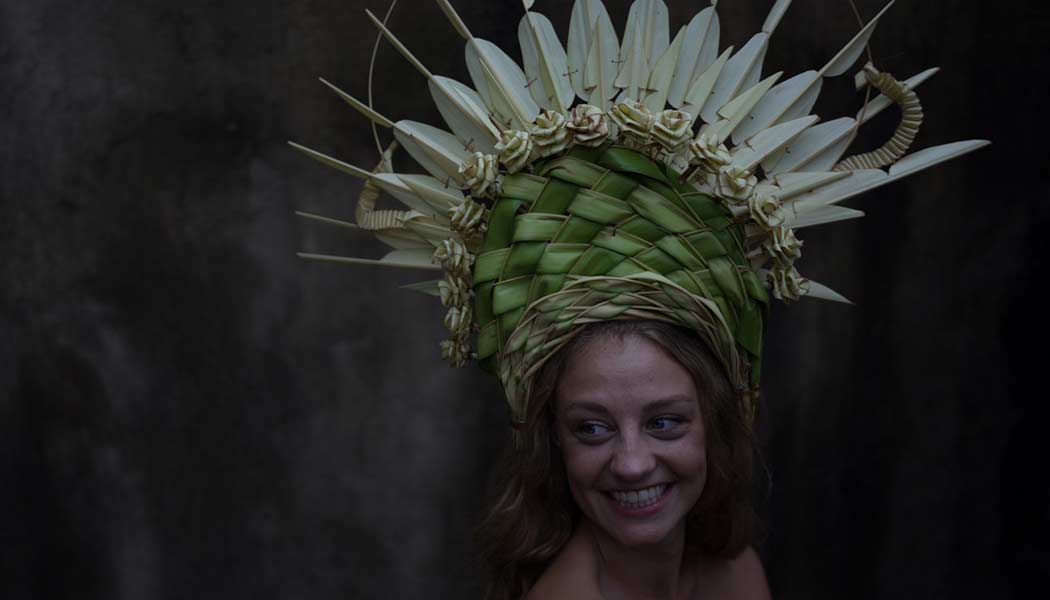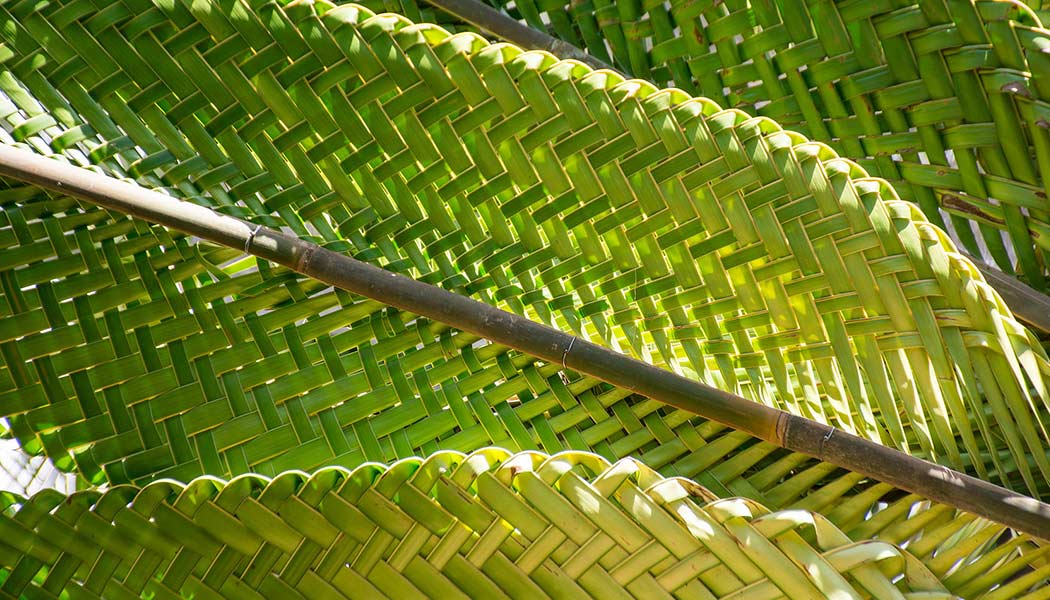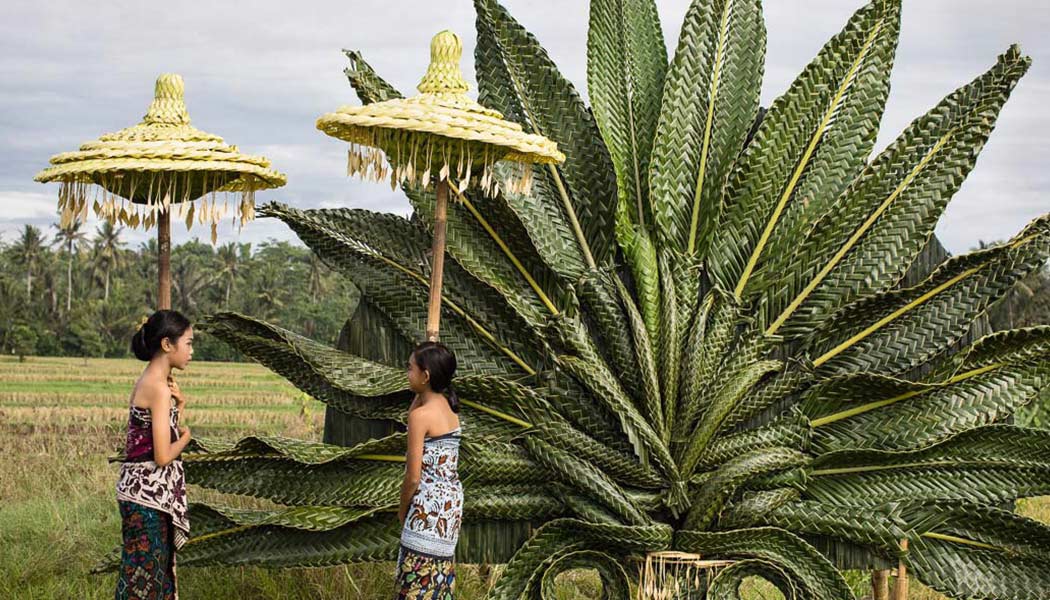Tony Stanton meets Chloe Quinn from Make A Scene to hear how her collaboration with local craftsmen is re-imagining a Bali tradition.

Photo: Andika Dana Pratama.
Hi Chloe… can you tell us a little about where you are from and what brought you to Bali?
I’m from Bristol, England, where I trained as a theatre designer. I first came out to Bali on holiday soon after I started university. We stayed in a homestay in a very traditional village called Bona and the family were so welcoming, immersing us in Balinese culture. On that first trip I fell in love with the island, the colours, the artistry, the landscape … and every year since I’ve returned. It’s the place that makes my soul happy. Whenever I was struggling as a freelance designer at home in the UK I transported myself back to Bali in my mind and it would calm me and lift my spirits. Choosing to always return to that same family in Bona, I discovered a workshop that built and installed Balinese wedding dekorasi. They were prepared to take me on as an apprentice, a match made in heaven. Bali meets theatre! I knew I had to follow my heart, so I took the plunge and moved here to start a new journey.

Photo: Andika Dana Pratama.
When did you first get the idea to use woven palm leaf in new and innovative ways?
The workshop I was with in Bona used carved and painted styrofoam to make their installations and although I was excited by the drama and theatricality of the scenic pieces, I gradually became aware that this was not a sustainable product and was in fact damaging to the environment. During the course of a conversation with the manager of Bambu Indah, she convinced me that I had to find a natural alternative for this art form. As fate would have it, weeks later she found and forwarded a Facebook post by Wayan Aksara. It showcased two innovative craftsmen from Mengwi who had just made their first completely natural, all leaf Balinese wedding dekorasi. “This is exactly what I mean!” she captioned. I was stunned by what I saw and my gut told me to go and find them asap!

Chloe Quinn by Krisna
My bahasa was non-existent at that point so I contacted Wayan Aksara who made the introduction for me and I was invited to their workshop. On my way there my GPS let me down and I got lost … it was my first bike ride out of Ubud. Finally I found the workshop, and the team were so welcoming and friendly and their handwoven, coconut leaf installations [the mature green coconut leaf here is known as slepan] were even more breath-taking in real life. I knew I had found something truly special. Gus Ari and his team had been experimenting with reintroducing original, traditional organic ways of decorating Balinese ceremonies. I just knew I had to help them reach a wider audience and share their incredible talent and craftsmanship with the rest of Bali.

How many are in the team and how long does it take to create some of the more epic designs?
There are three master weavers who are male and what is fantastic about this team is the strong female component. There are six skilled women weavers who are called upon when a large installation is being created – also the village mangku brings his signature skills to almost every piece. The workshop is always alive with a mix of the community: neighbours, grandchildren, young adults, grandparents … watching, admiring, becoming enthused and clearly proud that their traditional skill of weaving is enjoying a re-birth. I have become gradually more and more involved with the design side as my hands-on learning with the slepan leaf has enabled me to understand the potential and also the limitations of how the leaf can be manipulated. Together we are becoming more and more excited about the possibilities of what we can produce. The team of weavers and I are increasingly eager to challenge ourselves and their skills to expand their repertoire from the traditional forms to the sculptural. We are now also starting to take up inquiries from abroad with the possibility of exporting our installations.

Inspiring designs
The green leaf has an optimum shelf life of one week once it has been woven, consequently installations cannot be made more than one week in advance. However on more ambitions designs, the bamboo and rattan framework can be constructed well in advance. The fresh leaf gradually transitions into a silvery bronze as it reaches its fully dried out state and we have recently found that dried leaf installations are becoming equally popular. The bronze colour takes on an antique wood aesthetic and can be enjoyed for months and months as pieces of art.

Where do you get the ideas from for your creations?
My training as a theatre designer has taught me to be a magpie in my research. I look at catwalk designs, fashion shoots, fine art sculpture and installations, theatre sets and nature itself is a great inspiration especially here in Bali. I am constantly taking photos and making notes and sketches of what I come across on my daily bike rides.

What’s the most unusual design you have made?
At this moment the team are in the process of making a six-by-five metre stylised bonsai tree to showcase a collection of indigo garments for the Indonesian Fashion Council for the upcoming Creative Industries Conference. This is a new and exciting departure for us, taking us into the realm of visual merchandising and the fashion world.

This is a very Balinese tradition. How do you respect the cultural aspect of what you do at Make A Scene?
Our signature statement is: ‘Traditional Bali for Green Contemporary Events’. Members of the team are proud Balinese craftsmen and women with a profound knowledge of their traditions and culture. They stay true to making woven art and do not seek to introduce additional materials of a more contemporary nature. They let the quality and versatility of their weaving speak for itself. Our innovative designs prove that traditional methods can keep up with contemporary demands and can continue to surprise and excite. In addition, we are very proud of the fact that we have led a green movement in dekorasi across the island. Our green art is sustainable and biodegradable, using nature’s gifts respectfully and then returning them back to nature.

Are there any designs which are completely off limits?
We are very sensitive with the issue of religious iconography: motifs and symbols that are sacred.

How many varieties of palm do you work with?
Coconut leaf is the main leaf that we use. To be specific the leaf is called slepan. This is the stronger, more flexible and malleable leaf and we can source differing shades of green, darker and lighter. We also use busung leaf as a decorative element or as a highlight colour. This is also a coconut leaf, the type used for Balinese offerings. We use banana tree trunk to add three dimensional aspects such as the scales of our dragons and ijuk, a fibrous, organic hair-like material for the black hair of the dragons. Ambu and ratna flowers for decoration or signage.

Where does all the action happen? Do you make the pieces first and then transport them to venues or make them on site?
We build and weave all of the installations at the workshop in Mengwi. They are then transported to the venues and assembled in-situ.

What’s the most difficult aspect of the work?
Working against nature’s effect on the leaf. The leaf starts to dry out as soon as weaving begins. Therefore we have to carefully plan and time the build, working backwards from the event date to ensure maximum freshness. We also have to emphasize and communicate very clearly that the installations are made from natural materials and will consequently change visibly from their original vibrant green state as they gradually dry and transition tonally into an eventual beautiful bronze.

Will we ever see Make A Scene in other countries?
Yes! We have had interest already from a variety of countries. We are investigating all of the possibilities. The dried bronze leaf is much easier to export and we have in fact successfully sent pieces over to New York. So much would change for us and new doors would open if we could source an effective green preservative for the fresh leaf. However, first and foremost it is very important for us that our green art remains a biodegradable product that does not harm the environment. We will be joining Elami & Co Productions in the New Year and are very excited about this expansion.
Chloe best of luck, love the work.